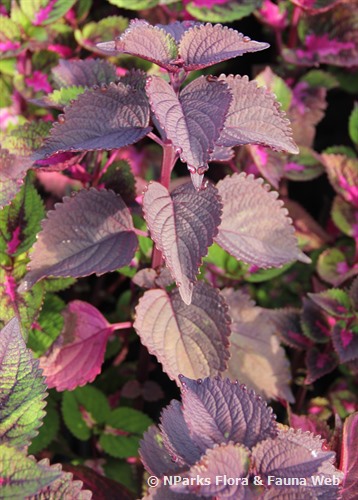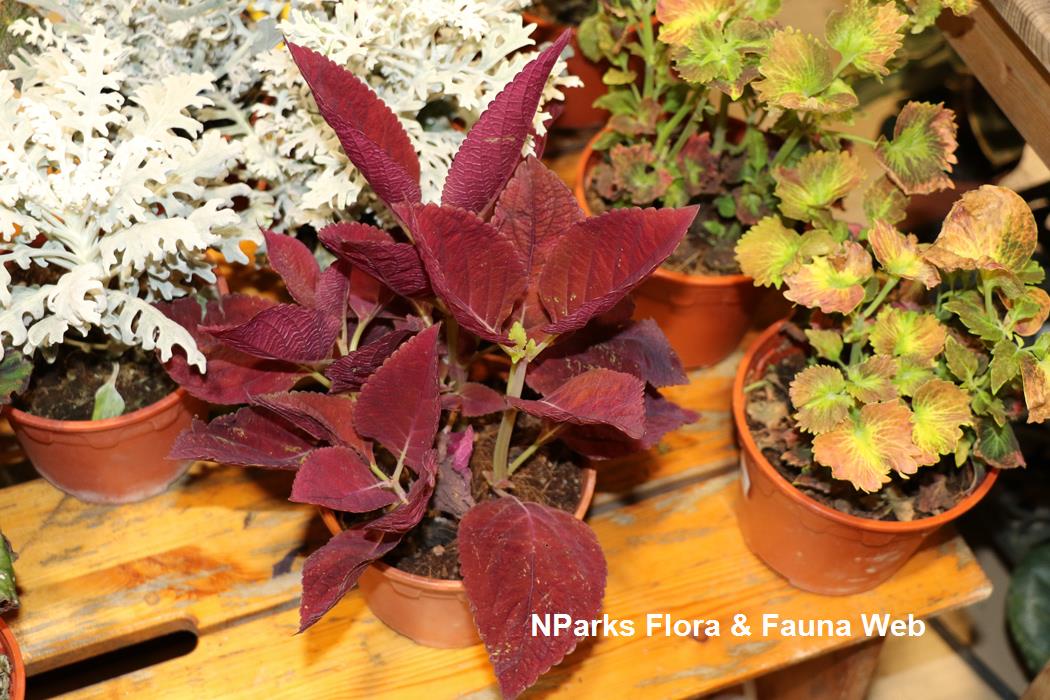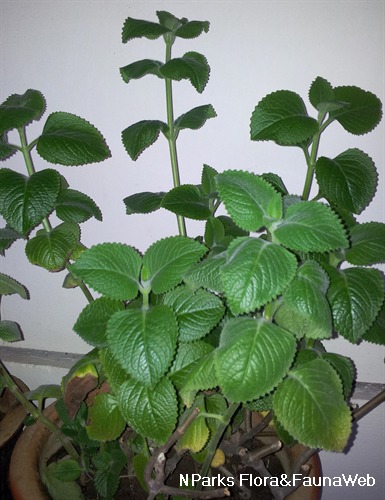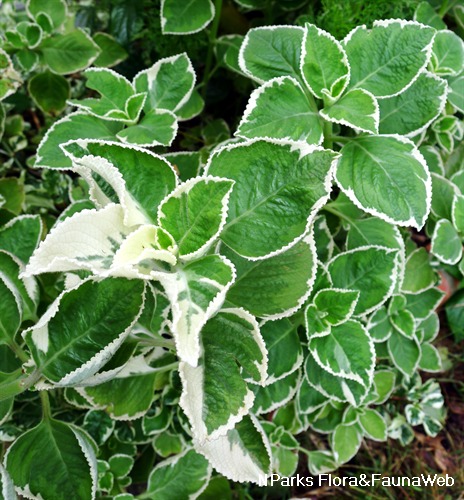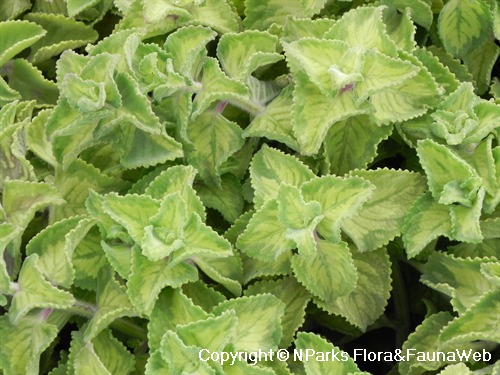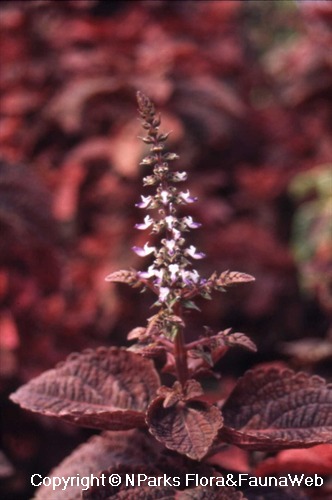
Back
Coleus scutellarioides (L.) Benth.
| Family Name: | Lamiaceae (Labiatae) |
| Synonyms: | Coleus verschaffeltii, Ocimum scutellarioides, Plectranthus scutellarioides |
| Common Name: | Painted Nettle, Flame Nettle, Common Coleus, 五彩苏, 洋紫蘇 |
Name
Classifications and Characteristics
| Plant Division | Angiosperms (Flowering Seed Plants) (Dicotyledon) |
|---|---|
| Plant Growth Form | Herbaceous Plant |
| Lifespan (in Singapore) | Annual, Perennial, Semi-Annual / Annual-Like |
| Mode of Nutrition | Autotrophic |
| Plant Shape | Shrubby |
| Maximum Height | 0.5 m |
| Maximum Plant Spread / Crown Width | 0.5 m |
Biogeography
| Native Distribution | China, Taiwan, India, Indochina, Indonesia, Malaysia, Papua New Guinea, Philippines, northern & western Australia, Solomon Islands |
|---|---|
| Native Habitat | Terrestrial |
| Preferred Climate Zone | Tropical, Sub-Tropical / Monsoonal, Temperate |
Description and Ethnobotany
| Growth Form | It is a bushy and compact herbaceous shrub which can grow up to 1 m tall. |
|---|---|
| Foliage | Leaves of various colours in attractive patterns, with coarsely crenate margins. |
| Stems | Herbaceous shrub, turns to semi-woody at base when mature. Stems squarish in cross-section. |
| Flowers | Flowers blue-white, produced in erect spikes at top of plant. |
| Fruit | Fruits brown, single-seeded achene-like nutlets, very small, held in persistent calyxes of inflorescence. |
| Taxonomy | Solenostemon scutellarioides and Coleus blumei are synonyms and former names for this plant. |
| Cultivation | Water regularly and do not let soil dry out. Propagate by seeds or stem cuttings. Plant is able to self-seed due to fallen nutlets. Perennial plant but normally grown as annual in Singapore. Plant tends to get leggy, sparse and less vigorous with age (especially after flowering). Tip-prune to promote bushy growth, and remove flower shoots as they appear. |
| Etymology | The genus Plectranthus comes from Greek which means spur-shaped flowers. The specific epithet scutellarioides means small dish or sauce, in reference to the shape of persistent calyx after flowers fade. |
Landscaping Features
| Landscaping | Easy to grow and fast-growing foliage plant, it is popularized during Victorian times for its showy multi-coloured leaves. It is suitable for growing in container planting, flowerbeds, and houseplants. It is also suitable for mass planting in a landscape. |
|---|---|
| Desirable Plant Features | Ornamental Flowers, Ornamental Foliage |
| Landscape Uses | General, Flowerbed / Border, Container Planting |
Fauna, Pollination and Dispersal
| Seed or Spore Dispersal | Abiotic (Gravity) |
|---|
Plant Care and Propagation
| Light Preference | Full Sun |
|---|---|
| Water Preference | Lots of Water |
| Plant Growth Rate | Fast |
| Rootzone Tolerance | Fertile Loamy Soils, Well-Drained Soils, Easy to Grow |
| Pruning | Pinch the plant tips to keep the plant compact and bushy. Remove the flower spikes as they appear. |
| Fertilizing | Fertilize with a balanced fertilizer to promote leaf production. |
| Potential Problems | No serious insect problems but watch for whiteflies or mealybugs if grow indoors. |
| Propagation Method | Seed, Stem Cutting |
| Maintenance Requirements Remarks | Plant tends to get leggy and less vigorous with age. Normally used as annual-like plant in Singapore. |
Foliar
| Foliage Retention | Evergreen |
|---|---|
| Mature Foliage Colour(s) | Cream / Off-White, Green, Pink, Purple, Red, White, Yellow / Golden |
| Mature Foliage Texture(s) | Velvety / Furry / Tomentose |
| Foliar Type | Simple / Unifoliate |
| Foliar Arrangement Along Stem | Opposite |
| Foliar Shape(s) | Non-Palm Foliage (Ovate) |
| Foliar Venation | Pinnate / Net |
| Foliar Margin | Crenate |
| Foliar Apex - Tip | Acuminate |
| Typical Foliar Area | Notophyll ( 20.25cm2 - 45 cm2 ), Mesophyll ( 45cm2 - 182.25 cm2 ) |
Non - Foliar and Storage
| Stem Type & Modification | Herbaceous |
|---|---|
| Root Type | Underground (Fibrous Root) |
Floral (Angiosperm)
| Flower & Plant Sexuality | Bisexual Flowers |
| Flower Colour(s) | Blue, White |
|---|---|
| Flower Grouping | Cluster / Inflorescence |
| Flower Location | Terminal |
| Flower Symmetry | Bilateral |
| Individual Flower Shape | Labiate / Lipped |
| Inflorescence Type | Raceme |
| Flowering Period | Free-Flowering |
Fruit, Seed and Spore
| Mature Fruit Colour(s) | Brown |
|---|---|
| Fruit Classification | Simple Fruit |
| Fruit Type | Indehiscent Dry Fruit , Nut / Nutlet |
Image Repository
Others
| Master ID | 1167 |
|---|---|
| Species ID | 2460 |
| Flora Disclaimer | The information in this website has been compiled from reliable sources, such as reference works on medicinal plants. It is not a substitute for medical advice or treatment and NParks does not purport to provide any medical advice. Readers should always consult his/her physician before using or consuming a plant for medicinal purposes. |

